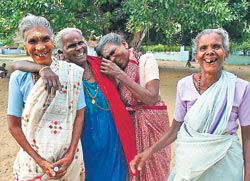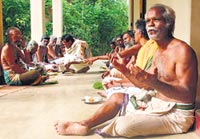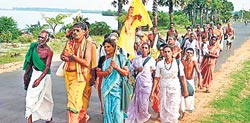
Devotion amidst uncertaintyOn June 19, ardent devotees from eastern districts assembled and set out from Sittandy Chitra Velayudha Swami Kovil in Batticaloa District on the annual Pada Yatra or coastal foot pilgrimage to Lord Skanda’s shrine in the South. The pilgrims this year started from Sittandy, rather than from Jaffna or Mullaitivu or Trincomalee as in years past, due to the prevailing security conditions in the Mutur and Vakarai coastal areas, said Chairman of the Kataragama Devotees Trust Manik Sandrasagra. Until last year the pilgrims had been walking all the way from Selva Sannidhi Murugan Kovil in Jaffna District. For many pilgrims the Pada Yatra is a chance to visit ancient shrines all the way to Kataragama in the company of veteran devotees. Their long trek takes them to famous temples at Sittandy, Mamamgam, Kaluthavalai, and Mandur in Batticaloa District. In Ampara District they follow the coast via Tirukkovil, Pottuvil and Okanda through Yala National Park to reach the Kataragama Sacred City on the flag-hoisting day.
Many pilgrims aim to reach Kataragama this year on July 15 for the flag hoisting ceremony. With only a week remaining before the flag-hoisting ceremony, hundreds of pilgrims are now surging into Yala National Park on the final leg of their long trek. Hundreds, even thousands more, will follow during the course of the festival. Since 1988 the Kataragama Devotees Trust has annually organized the Pada Yatra by notifying devotees, societies and temples all along the East Coast. This facilitates the planning for dana, the ritual offering of food that is essential to the pilgrims, since most are poor villagers and none can carry food for weeks. All along the route, villagers await their chance to offer annadanam to the growing bands of pilgrims, who are mostly in their 50’s, 60’s and 70’s. Some pilgrims may be seen carrying the Kataragama God’s bright red and yellow cock banner. Others wave peacock feathers, while senior swamis bear aloft the Vel or lance, symbol of the God’s invincibility. Even small children dressed in vetti may be seen accompanying their grandmothers, shouting ‘Haro Hara!’ (‘Hallelujah’), and joining in the constant recital of bhajans in praise of God Kataragama. Pilgrims sleep under the stars at night or in temples, but never in private homes. Consumption of alcohol is strictly prohibited. Elder pilgrims especially enjoy the respect of villagers and pilgrims alike, who consider them as treasuries of age-old poetic traditions. Many villagers take vows to join the Pada Yatra as it passes through their own village, so the parties of pilgrims tend to grow as they proceed from village to village.
Traditional pilgrims are easily recognized by their authentic pilgrim’s attire: vettis and shawl for men, saris for women, and all go barefoot singing as they walk southward. Trousers, shirts, or shoes are considered unacceptable attire for pilgrims. In recent years however, some novice groups, calling themselves Pada Yatra pilgrims, have been encouraging youths to walk without observing the customary restrictions. Some youths wear shirts, trousers, hats and shoes. Some carry transistor radios for entertainment at night. Others bring drums to accompany loud baila music. Lately some societies and NGOs have started to bring luxury vehicles and tractors to transport electrical generators, tents, and people even through the Strict Natural Reserve of Yala National Park. These practices are harmful both to the hallowed traditions themselves and to the fragile protected ecosystems, said Sandrasagra. He appealed to public and government alike to restrict seasonal activities within Yala National Park to traditional pilgrimage only. The age-old tradition of Pada Yatra fell into abeyance with the 1983 civil disturbances but was revived in 1988 under the Kataragama Devotees Trust patronage. The number of pilgrims had been growing steadily until the resumption of hostilities last year. In 2004 Wildlife Department officials counted over 30,000 pilgrims entering Yala East National Park on the final 70-kilometre stretch. This year due to security concerns far fewer foot pilgrims are expected. The KDT has developed a highly popular website for Kataragama devotees at www.Kataragama.org. Even the Pada Yatra pilgrims have their own website at www.PadaYatra.org. “We are a network of devotees from all over the world,” says Sandrasagra, noting that the popular website also plays a role in attracting foreign devotees and international media, including The Discovery Channel. Even today in neighbouring countries like India, religious processions and pilgrimages are sources of communal friction and even violence. But the Kataragama Pada Yatra is actually a source of consensus and communal harmony, a fact that Sri Lankans may rightly reflect upon and be grateful for.
Today, more than ever, the traditional Kataragama Pada Yatra remains a powerful symbol of peace and reconciliation that is hailed and understood by Sri Lankans of all religious and ethnic backgrounds. This year is the 20th consecutive Pada Yatra sponsored by the Kataragama Devotees Trust since 1988 with the support of villagers and officials at the national, district and local levels. “We have been privileged to keep the lamp burning through all these long dark years,” says Sandrasagra, adding “Now we are holding it up for all to see.” |
|| Front
Page | News | Editorial | Columns | Sports | Plus | Financial
Times | International | Mirror | TV
Times | Funday
Times || |
| |
Copyright
2007 Wijeya
Newspapers Ltd.Colombo. Sri Lanka. |


